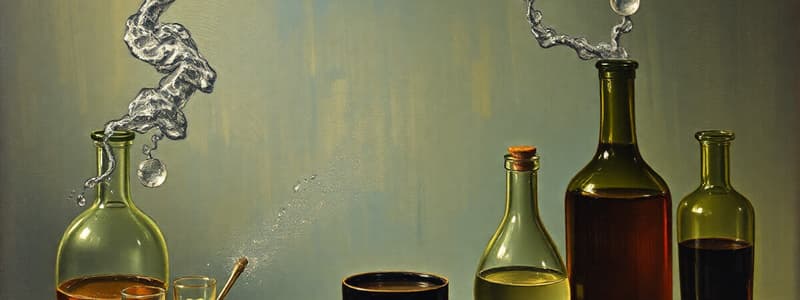Podcast
Questions and Answers
Why should a magnesium ribbon be cleaned before burning in air?
Why should a magnesium ribbon be cleaned before burning in air?
A magnesium ribbon should be cleaned before burning in air to remove any oxide layer that might be present on its surface. This layer can interfere with the combustion process and prevent the ribbon from burning brightly. The cleaning ensures a more vigorous reaction.
Write the balanced equation for the following chemical reactions: Hydrogen + Chlorine → Hydrogen chloride
Write the balanced equation for the following chemical reactions: Hydrogen + Chlorine → Hydrogen chloride
H₂ + Cl₂ → 2HCl
Write the balanced equation for the following chemical reactions: Barium chloride + Aluminium sulphate → Barium sulphate + Aluminium chloride
Write the balanced equation for the following chemical reactions: Barium chloride + Aluminium sulphate → Barium sulphate + Aluminium chloride
3BaCl₂ + Al₂(SO₄)₃ → 3BaSO₄ + 2AlCl₃
Write the balanced equation for the following chemical reactions: Sodium + Water → Sodium hydroxide + Hydrogen
Write the balanced equation for the following chemical reactions: Sodium + Water → Sodium hydroxide + Hydrogen
Write a balanced chemical equation with state symbols for the following reactions: Solutions of barium chloride and sodium sulphate in water react to give insoluble barium sulphate and the solution of sodium chloride.
Write a balanced chemical equation with state symbols for the following reactions: Solutions of barium chloride and sodium sulphate in water react to give insoluble barium sulphate and the solution of sodium chloride.
Write a balanced chemical equation with state symbols for the following reactions: Sodium hydroxide solution (in water) reacts with hydrochloric acid solution (in water) to produce sodium chloride solution and water.
Write a balanced chemical equation with state symbols for the following reactions: Sodium hydroxide solution (in water) reacts with hydrochloric acid solution (in water) to produce sodium chloride solution and water.
A solution of a substance 'X' is used for whitewashing. (i) Name the substance 'X' and write its formula. (ii) Write the reaction of the substance 'X' named in (i) above with water.
A solution of a substance 'X' is used for whitewashing. (i) Name the substance 'X' and write its formula. (ii) Write the reaction of the substance 'X' named in (i) above with water.
Why is the amount of gas collected in one of the test tubes in Activity 1.7 double of the amount collected in the other? Name this gas.
Why is the amount of gas collected in one of the test tubes in Activity 1.7 double of the amount collected in the other? Name this gas.
Why does the iron nail become brownish in colour and the blue colour of copper sulphate solution fades?
Why does the iron nail become brownish in colour and the blue colour of copper sulphate solution fades?
Give an example of a double displacement reaction other than the one given in Activity 1.10.
Give an example of a double displacement reaction other than the one given in Activity 1.10.
Identify the substances that are oxidised and the substances that are reduced in the following reactions: (i) 4Na(s) + O₂(g) → 2Na₂O(s) (ii) CuO(s) + H₂(g) → Cu(s) + H₂O(l)
Identify the substances that are oxidised and the substances that are reduced in the following reactions: (i) 4Na(s) + O₂(g) → 2Na₂O(s) (ii) CuO(s) + H₂(g) → Cu(s) + H₂O(l)
Why does the colour of copper sulphate solution change when an iron nail is dipped in it?
Why does the colour of copper sulphate solution change when an iron nail is dipped in it?
What is the difference between displacement and double displacement reactions? Write equations for these reactions.
What is the difference between displacement and double displacement reactions? Write equations for these reactions.
In the refining of silver, the recovery of silver from silver nitrate solution involved displacement by copper metal. Write down the reaction involved.
In the refining of silver, the recovery of silver from silver nitrate solution involved displacement by copper metal. Write down the reaction involved.
What do you mean by a precipitation reaction? Explain by giving examples.
What do you mean by a precipitation reaction? Explain by giving examples.
Explain the following in terms of gain or loss of oxygen with two examples each. (a) Oxidation (b) Reduction
Explain the following in terms of gain or loss of oxygen with two examples each. (a) Oxidation (b) Reduction
A shiny brown coloured element ‘X' on heating in air becomes black in colour. Name the element ‘X’ and the black coloured compound formed.
A shiny brown coloured element ‘X' on heating in air becomes black in colour. Name the element ‘X’ and the black coloured compound formed.
Why do we apply paint on iron articles?
Why do we apply paint on iron articles?
Oil and fat containing food items are flushed with nitrogen. Why?
Oil and fat containing food items are flushed with nitrogen. Why?
Explain the following terms with one example each. (a) Corrosion (b) Rancidity
Explain the following terms with one example each. (a) Corrosion (b) Rancidity
Write one equation each for decomposition reactions where energy is supplied in the form of heat, light or electricity.
Write one equation each for decomposition reactions where energy is supplied in the form of heat, light or electricity.
Which of the statements about the reaction below are incorrect? 2PbO(s) + C(s) → 2Pb(s) + CO₂(g) (a) Lead is getting reduced. (b) Carbon dioxide is getting oxidised. (c) Carbon is getting oxidised. (d) Lead oxide is getting reduced.
Which of the statements about the reaction below are incorrect? 2PbO(s) + C(s) → 2Pb(s) + CO₂(g) (a) Lead is getting reduced. (b) Carbon dioxide is getting oxidised. (c) Carbon is getting oxidised. (d) Lead oxide is getting reduced.
Flashcards
Chemical Reaction
Chemical Reaction
A change in the nature and identity of a substance, indicating a new substance has been formed.
Reactants
Reactants
The substances that undergo a chemical change in a reaction, reacting with each other to form new substances.
Products
Products
The new substances formed during a chemical reaction.
Combination Reaction
Combination Reaction
Signup and view all the flashcards
Decomposition Reaction
Decomposition Reaction
Signup and view all the flashcards
Exothermic Reactions
Exothermic Reactions
Signup and view all the flashcards
Endothermic Reactions
Endothermic Reactions
Signup and view all the flashcards
Displacement Reaction
Displacement Reaction
Signup and view all the flashcards
Double Displacement Reaction
Double Displacement Reaction
Signup and view all the flashcards
Precipitation Reaction
Precipitation Reaction
Signup and view all the flashcards
Oxidation
Oxidation
Signup and view all the flashcards
Reduction
Reduction
Signup and view all the flashcards
Balanced Chemical Equation
Balanced Chemical Equation
Signup and view all the flashcards
Chemical Equation
Chemical Equation
Signup and view all the flashcards
Corrosion
Corrosion
Signup and view all the flashcards
Rancidity
Rancidity
Signup and view all the flashcards
Antioxidants
Antioxidants
Signup and view all the flashcards
Digestion
Digestion
Signup and view all the flashcards
Respiration
Respiration
Signup and view all the flashcards
Oxidation of Metals
Oxidation of Metals
Signup and view all the flashcards
Reduction of Metal Oxides
Reduction of Metal Oxides
Signup and view all the flashcards
Precipitation Reaction
Precipitation Reaction
Signup and view all the flashcards
Exothermic Reaction
Exothermic Reaction
Signup and view all the flashcards
Endothermic Reaction
Endothermic Reaction
Signup and view all the flashcards
Chemical Formula
Chemical Formula
Signup and view all the flashcards
Physical State
Physical State
Signup and view all the flashcards
State Symbol
State Symbol
Signup and view all the flashcards
Left-Hand Side (LHS) of a Chemical Equation
Left-Hand Side (LHS) of a Chemical Equation
Signup and view all the flashcards
Right-Hand Side (RHS) of a Chemical Equation
Right-Hand Side (RHS) of a Chemical Equation
Signup and view all the flashcards
Arrow in a Chemical Equation
Arrow in a Chemical Equation
Signup and view all the flashcards
Study Notes
Chemical Reactions and Equations
- Chemical reactions involve changes in the nature and identity of substances.
- Chemical reactions can be observed through changes in state, color, temperature, and formation of gases.
- Chemical reactions involve breaking and forming bonds between atoms.
- Chemical reactions have reactants (substances undergoing change) and products (new substances created).
Activity 1.1
- Magnesium ribbon burns in air to form magnesium oxide.
- This reaction involves a change of state and color and can be observed through exothermicity.
- Observation of a change during reaction can help determine if a chemical process has occurred.
Activity 1.2
- Lead nitrate and potassium iodide react in a test tube, generating a change in the solution.
Activity 1.3
- Zinc granules react with dilute hydrochloric/sulfuric acid, forming a gas (hydrogen) and releasing energy.
- This reaction is observed by noting the gas formation and/or temperature change.
1.1 Chemical Equations
- Word equations represent chemical reactions using words instead of symbols.
- Chemical equations show reactants and products using their formulas.
- Equations contain symbols like: +, →, (s), (l), (g), (aq) - these signify reactants, products, solid, liquid, gas, and aqueous respectively.
- Chemical equations must balance, maintaining the same number of atoms for each element both on the product and reactant sides.
1.1.2 Balanced Chemical Equations
- The law of conservation of mass states that mass cannot be created or destroyed during a chemical reaction.
- This means balancing chemical equations is a necessary detail that needs to satisfy this equation in order to be a valid chemical equation.
- Balancing maintains the same number of atoms of each element on both sides.
1.2 Types of Chemical Reactions
- Combination reaction: Two or more reactants forming a single product.
-Example: Formation of water from hydrogen and oxygen
- Example: Formation of calcium hydroxide from calcium oxide and water.
- Decomposition reaction: A single reactant breaking down into two or more products. -Example: Decomposition of ferrous sulphate at heat. -Example: Decomposition of lead nitrate at heat.
1.2.3 Displacement Reaction
- One element replaces another in a compound.
- Example: Iron replacing copper in copper sulphate solution.
- Example: Zinc replacing copper in copper sulphate solution.
1.2.4 Double Displacement Reaction
- An exchange of ions occurs between two compounds.
- Example: Formation of barium sulphate precipitate by mixing sodium sulphate and barium chloride solutions.
1.2.5 Oxidation and Reduction (Redox) Reactions
- Oxidation: Gain of oxygen or loss of hydrogen in a chemical reaction. -Example: Copper reacting with oxygen to form copper(II) oxide
- Reduction: Loss of oxygen or gain of hydrogen in a chemical reaction.
- Example: Copper(II) oxide reacting with hydrogen to form copper.
Questions
- Questions on chemical reactions are provided for self-assessment.
Studying That Suits You
Use AI to generate personalized quizzes and flashcards to suit your learning preferences.




